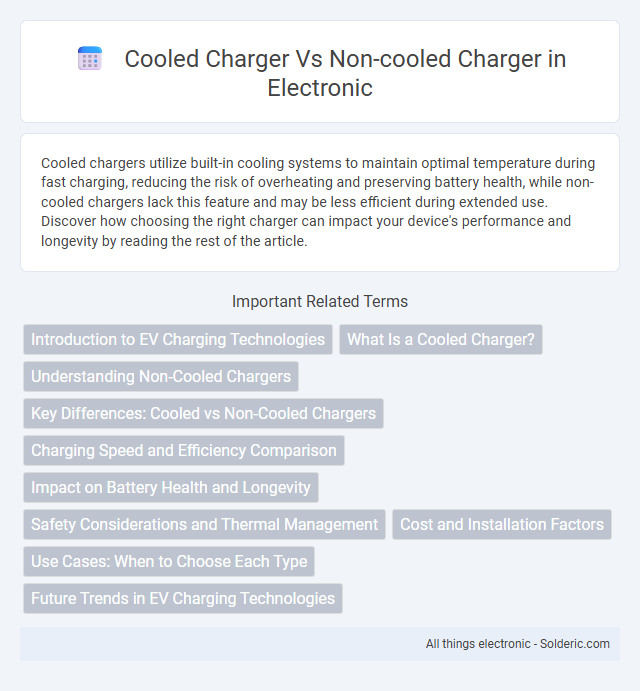Cooled chargers utilize built-in cooling systems to maintain optimal temperature during fast charging, reducing the risk of overheating and preserving battery health, while non-cooled chargers lack this feature and may be less efficient during extended use. Discover how choosing the right charger can impact your device's performance and longevity by reading the rest of the article.
Comparison Table
| Feature | Cooled Charger | Non-Cooled Charger |
|---|---|---|
| Cooling Mechanism | Active cooling with fans or liquid systems | No active cooling; relies on natural convection |
| Efficiency | Higher efficiency due to controlled temperature | Lower efficiency; performance may drop with heat |
| Performance | Stable under high loads and long charging sessions | Performance may degrade under heavy or prolonged use |
| Lifespan | Extended lifespan; reduced thermal stress | Shorter lifespan due to heat exposure |
| Cost | Higher upfront cost due to cooling components | Lower initial cost |
| Noise Level | May generate noise from cooling fans | Silent operation |
| Use Case | Ideal for fast charging and high-power requirements | Suitable for low-power or intermittent charging |
Introduction to EV Charging Technologies
Cooled chargers utilize liquid or air cooling systems to maintain optimal operating temperatures, enhancing efficiency and prolonging battery life during fast charging sessions. Non-cooled chargers rely on passive heat dissipation, which can lead to slower charging speeds and increased thermal stress on the EV battery. Understanding these differences helps you select the best EV charger technology tailored to your vehicle's charging needs and performance expectations.
What Is a Cooled Charger?
A cooled charger incorporates built-in cooling mechanisms, such as fans or liquid cooling systems, to dissipate heat generated during the charging process, ensuring optimal temperature control and enhanced safety. This temperature regulation helps prevent overheating, prolongs the charger's lifespan, and maintains charging efficiency. Non-cooled chargers lack these cooling features, which can lead to higher operating temperatures and potential thermal throttling or damage under heavy use.
Understanding Non-Cooled Chargers
Non-cooled chargers operate without active cooling systems, relying on passive heat dissipation through natural convection or conduction. These chargers are typically simpler, more compact, and cost-effective but may experience higher operating temperatures, which can affect charging efficiency and durability. Understanding your non-cooled charger's thermal limits helps ensure safe and optimal performance, especially during extended or high-power charging sessions.
Key Differences: Cooled vs Non-Cooled Chargers
Cooled chargers utilize advanced thermal management systems, such as fans or liquid cooling, to maintain optimal operating temperatures, enhancing efficiency and extending battery life. Non-cooled chargers rely on passive heat dissipation, which can lead to higher thermal buildup, reduced charging speed, and potential overheating risks. Effective cooling in chargers is crucial for maintaining charge cycles, preventing thermal degradation, and ensuring safe, consistent power delivery.
Charging Speed and Efficiency Comparison
Cooled chargers utilize advanced thermal management technologies to maintain optimal operating temperatures, enabling faster charging speeds by preventing overheating and allowing higher current flow. Non-cooled chargers often reduce charging efficiency as heat buildup forces them to throttle power delivery, resulting in slower charge times and increased energy loss. Efficient heat dissipation in cooled chargers enhances overall energy transfer, making them more effective for high-capacity battery systems and rapid charging applications.
Impact on Battery Health and Longevity
Cooled chargers regulate temperature during charging, significantly reducing thermal stress on battery cells, which enhances overall battery health and extends battery longevity. Non-cooled chargers allow heat buildup, accelerating battery degradation and reducing lifespan due to increased chemical instability. Optimizing charge temperature through cooled charging systems is crucial for maintaining optimal battery capacity and prolonging cycle life.
Safety Considerations and Thermal Management
Cooled chargers integrate advanced thermal management systems, such as liquid cooling or enhanced airflow mechanisms, to maintain safe operating temperatures and prevent overheating, significantly reducing fire hazards and extending the charger's lifespan. Non-cooled chargers rely on passive heat dissipation through materials and ventilation but may pose a higher risk of thermal buildup under heavy usage, potentially compromising safety and efficiency. Choosing a cooled charger ensures better protection for your devices by maintaining optimal thermal conditions during charging.
Cost and Installation Factors
Cooled chargers generally incur higher upfront costs due to the inclusion of cooling systems designed to manage heat and enhance performance, whereas non-cooled chargers are less expensive and simpler to install. Installation of cooled chargers may require additional infrastructure such as ventilation or liquid cooling setups, increasing both time and labor expenses. Non-cooled chargers offer easier integration in existing spaces without specialized modifications, making them more cost-effective for installations with budget constraints.
Use Cases: When to Choose Each Type
Cooled chargers are ideal for high-power applications such as electric vehicle fast charging stations and industrial equipment due to their ability to maintain optimal performance under continuous heavy use. Non-cooled chargers suit low to moderate power demands like home electronics and portable device charging, where heat dissipation is less critical. Selecting cooled or non-cooled chargers depends primarily on the charger's power output, duration of use, and thermal management needs to ensure safety and efficiency.
Future Trends in EV Charging Technologies
Cooled chargers utilize liquid or air cooling systems to manage heat, enabling higher power output and faster charging speeds compared to non-cooled chargers, which rely on passive cooling methods. Future EV charging technologies are trending towards more efficient cooled chargers integrated with smart thermal management to support rapid charging while preserving battery health. Innovations such as solid-state cooling and advanced heat dissipation materials are expected to enhance charger performance and accelerate the adoption of ultra-fast EV charging stations worldwide.
Cooled charger vs Non-cooled charger Infographic

 solderic.com
solderic.com